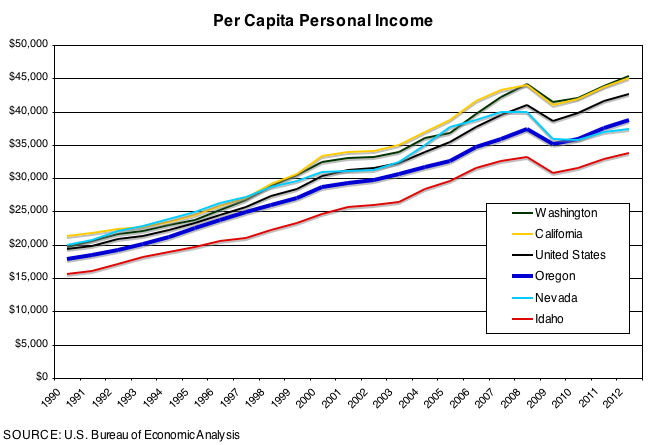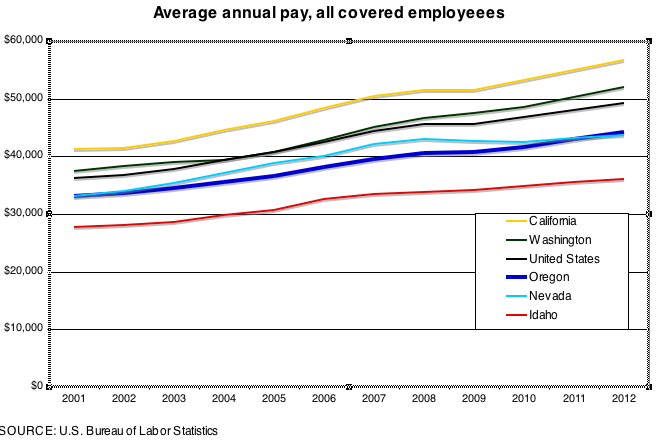BY BRANDON SAWYER | OB RESEARCH EDITOR
 Oregon’s per capita personal income has been slipping further behind levels in Washington and California as well as the nation as a whole since the late ’90s. The recession of the early 2000s seems to have dealt a heavier blow here than other states and income wasn’t as quick to bounce back.
Oregon’s per capita personal income has been slipping further behind levels in Washington and California as well as the nation as a whole since the late ’90s. The recession of the early 2000s seems to have dealt a heavier blow here than other states and income wasn’t as quick to bounce back.
BY BRANDON SAWYER | OB RESEARCH EDITOR
 Oregon’s per capita personal income (PCPI), as measured by the Bureau of Economic Analysis, has been slipping further behind levels in Washington and California as well as the nation as a whole since the late ’90s. The recession of the early 2000s seems to have dealt a heavier blow here than other states and income wasn’t as quick to bounce back before the Great Recession hit a few years later.
Oregon’s per capita personal income (PCPI), as measured by the Bureau of Economic Analysis, has been slipping further behind levels in Washington and California as well as the nation as a whole since the late ’90s. The recession of the early 2000s seems to have dealt a heavier blow here than other states and income wasn’t as quick to bounce back before the Great Recession hit a few years later.
The figure is calculated by taking the personal income of residents in a given area, wages and salary as well as investment returns and dividends, and dividing that by the area’s population. In 1992, Oregon’s PCPI of $17,895 represented less than 93% Of U.S. PCPI. By ’96, it had risen above 97% but the gap widened again in ensuing years and in 2012, Oregon’s PCPI of $38,786 was less than 91% of U.S. PCPI of $42,693.
Our coastal neighbors are not in the same boat. California has had significantly higher than average PCPI for decades, and Washington was only slightly better than average through most of the ’90s but in the last decade it has pulled away from U.S. level and even surpassed California for the last five years. Washington’s PCPI in 2012 was $45,413 and California’s was $44,980.
Yet Oregon leads its sparser populated inland neighbors. Nevada tracked closely with U.S. PCPI up until the late 2000s when it fell below Oregon’s level to $37,361 in 2012, and Idaho has long trailed Oregon in personal income. It had 2012’s second-lowest PCPI among the 50 states at $33,749.

Within Oregon, the top five counties for PCPI as of 2011, and the only ones above the statewide average, were Sherman ($55.2K), Clackamas ($45.9K), Washington ($42.6K), Multnomah ($$41.7) and Benton ($38.7). With the exception of Sherman, there seems to be some correlation with Portland Metro and Corvallis high-tech jobs and higher PCPI.
Of course, factors beyond pay and other forms of income can greatly influence PCPI. If the population increases due to childbirth, or an influx of retirees or jobless 20-somethings with scant income, it will go down. If long-standing industries such as forest products shutter mills and lay off workers, but the population sticks around, it will likewise falter. And PCPI has also been driven down by the state’s historically (and currently) higher-than-average unemployment and its lower-than-average labor force participation rate which I discussed in a blog last month. The state Employment Department recently put out an insightful report analyzing potential reasons behind flagging labor force participation that connects it to diminished PCPI.
Still, for Oregon, pay is a major factor. Its average annual pay for all covered employees, as compiled by the Bureau of Labor Statistics, was $44,271 in 2012, compared to $51,966 in Washington and $49,289 nationally. In 2001, Oregon’s average pay was about 92% of average U.S. pay, but since 2005 it’s fallen below 90%. Neighboring state’s follow a similar pattern for pay as for PCPI.
If the state is ever going to close the gap on PCPI with the rest of the nation, it needs to attract companies that locate high-paying occupations, and hopefully their headquarters, in-state; boost jobs in general to reduce unemployment; and increase average pay enough to entice non-participants back into the workforce. There is hope. While our PCPI still lags, notes the Employment Department, its latest growth rate is relatively strong.

Research editor Brandon Sawyer digs heaps of data about privately-held and public companies, economics and industries, and extracts relevant articles, graphs and lists, including the 100 Best Companies, Nonprofits and Green Companies to Work For in Oregon.


